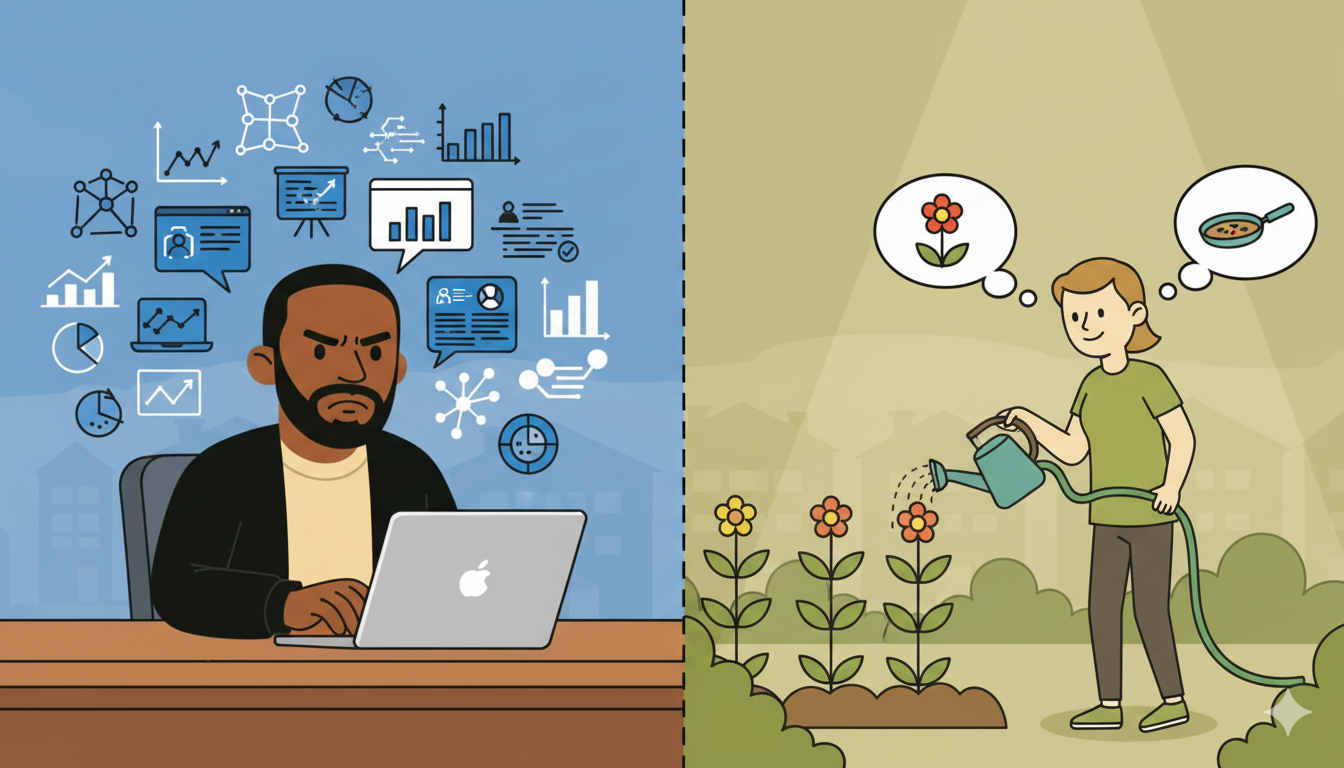The Power of Perspective: Why Your Biggest Challenge Isn't Your Neighbor's Priority
When Everything Feels Like Everything
Have you ever noticed how a single upcoming event can consume your entire mental bandwidth? That presentation to the C-suite, the client pitch that could make or break your quarter, or even a difficult conversation you've been putting off – suddenly, it feels like the most important thing in the universe.
Perspective is powerful.
I've been reflecting on this lately, particularly after catching myself spiraling over what was, objectively, just another Tuesday meeting. But in my mind, it had grown into this make-or-break moment that would define my entire career trajectory. Sound familiar?
The Neighbor Test
Here's what snapped me out of it: I realized my neighbor was probably thinking about something completely different at that exact moment. Maybe they were worried about their kid's soccer practice, planning dinner, or dealing with a leaky faucet. Their world – their priorities, concerns, and focus – existed in an entirely different universe from mine.
This isn't to diminish what we're going through. Our challenges are real, and they matter. But there's something profoundly grounding about remembering that what feels all-consuming to us is just one thread in the vast tapestry of human experience happening simultaneously around us.
When I Caught Myself in the Trap
I've been thinking about this more lately, especially after catching myself getting completely consumed by anticipating an upcoming event. You know how it goes – maybe it's a big meeting, a presentation, something for a client, or even just a difficult conversation you've been putting off. Whatever it is, suddenly it becomes this all-consuming thing that takes up way more mental space than it deserves.
What struck me was realizing that while I'm wrapped up in this one thing, my neighbor is thinking about a completely different world. They have their own priorities, their own concerns, their own focus. It doesn't mean what I'm dealing with isn't important, but it's a matter of having proper perspective and placing it where it needs to be.
This awareness has helped me think differently about how I navigate my career and life in general. It's helped me compartmentalize where I need to put my focus and priorities, as well as the effort I'm putting in.
The Compartmentalization Strategy
This perspective shift led me to develop what I call the "compartmentalization strategy" – a way to properly place challenges and priorities in their appropriate containers without letting them overflow into everything else.
Step 1: Acknowledge the Reality
First, I acknowledge that what I'm dealing with is real and important within its proper context. I don't dismiss or minimize my challenges – they deserve appropriate attention and effort.
Step 2: Zoom Out
Then I consciously zoom out and remind myself of the bigger picture. I think about all the other people dealing with their own priorities, challenges, and opportunities at this exact moment. This isn't about making my problems feel small, but about putting them in proper perspective.
Step 3: Define the Container
I create a specific container for the challenge – both in terms of time and mental energy. If I have a big presentation, I dedicate specific hours to preparation and worry, but I don't let it leak into family dinner or my morning walk.
Step 4: Focus on the Controllable
Finally, I redirect my energy toward what I can actually control. I can control my preparation, my mindset, and my response to outcomes. I can't control every variable or guarantee specific results.
Why This Matters for Your Career
In technology and leadership, we're constantly facing high-stakes situations. Product launches, team restructures, strategic pivots, difficult conversations with stakeholders – the list is endless. Without proper perspective, we can burn out from treating every challenge like a life-or-death situation.
I've learned that my best decisions come when I'm neither dismissive of challenges nor completely consumed by them. There's a sweet spot where you take something seriously enough to prepare and perform well, but not so seriously that you lose sight of everything else that matters.
The Practice of Perspective
Building this perspective muscle takes practice. Here are some approaches that have worked for me:
The One-Year Test: Ask yourself, "Will this matter in a year?" Often, the answer provides immediate perspective relief.
The Neighbor Check: Literally think about what someone else might be prioritizing right now. It's a humbling reminder of life's diversity.
The Container Visualization: Imagine putting your challenge in a box with clear boundaries. You can open the box when it's time to work on it, but you can also close it.
The Energy Audit: Regularly assess whether your energy allocation matches the actual importance of various priorities.
When Perspective Gets Difficult
I want to be honest about something: there are times when maintaining perspective feels nearly impossible. When you're facing a potential layoff, a serious health concern, or a relationship crisis, telling yourself to "just get perspective" can feel dismissive of real pain and real stakes.
In these moments, I've found that the goal isn't to minimize the importance of what you're facing, but to prevent it from completely overwhelming your ability to function in other areas of life. Even in truly difficult times, there can be value in creating small pockets of normalcy and maintaining connections to the broader world.
The Technology Leader's Perspective Challenge
As technology professionals, we face unique perspective challenges. We're often working on innovations that we believe will change the world, solving problems that feel monumentally important, and operating in an industry that moves at breakneck speed.
The challenge is maintaining appropriate urgency and excellence while not losing ourselves in the process. Some of the most effective tech leaders I know have mastered this balance – they care deeply about outcomes while maintaining perspective on their place in the larger ecosystem.
Building a Perspective-Rich Culture
If you're in a leadership role, consider how you can help your team maintain healthy perspective. This might mean:
Modeling balanced responses to setbacks and challenges
Regularly connecting work to broader purpose and impact
Encouraging time off and boundaries
Celebrating progress, not just final outcomes
Sharing your own perspective struggles and how you navigate them
Moving Forward with Clarity
The goal isn't to become indifferent to challenges or to stop caring about outcomes. The goal is to develop the ability to zoom in when focus is needed and zoom out when perspective is required.
Your biggest challenge today – that presentation, that difficult conversation, that career decision – it matters. But it's also just one piece of a much larger puzzle. Your neighbor has their own puzzle pieces they're working on. Neither is more or less important; they're just different parts of the human experience.
As you navigate your career and life, consider practicing this art of perspective. Notice when you're getting consumed by a single challenge. Ask yourself where this really fits in the bigger picture. Create appropriate containers for your focus and energy. And remember that while your challenges are real and valid, they're happening alongside millions of other real and valid human experiences.
The most resilient and effective leaders I know aren't the ones who never face challenges – they're the ones who have learned to maintain perspective while still bringing their best effort to what matters most.
What's your biggest challenge right now, and how might shifting your perspective change how you approach it? I'd love to hear how you maintain balance between caring deeply and keeping perspective – share your thoughts and experiences in the comments below.
About the Author
Jeremy Mckellar is a Connector, Creative, and Tech Futurist focused on making technology meaningful and accessible. Connect with him on LinkedIn or follow his thoughts on technology at JeremyMckellar.com.
AI Collaboration Disclosure: This article was developed in collaboration with AI as a thinking partner to help synthesize and organize my thoughts. I believe AI tools can amplify our human insights when used thoughtfully – consider exploring how these tools might enhance your own content creation and strategic thinking.

